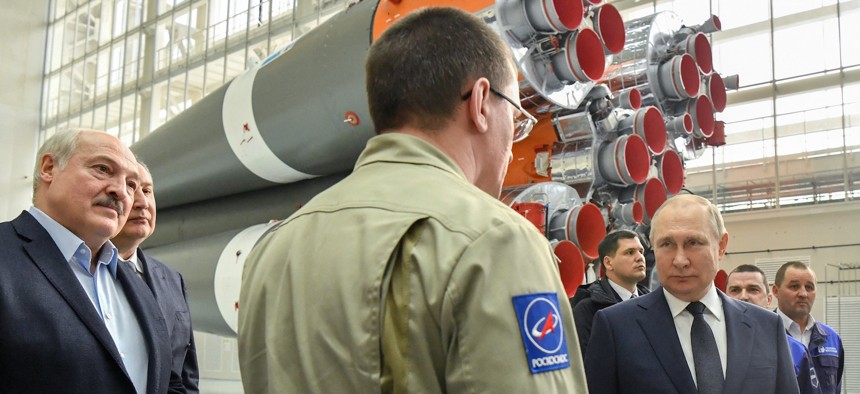Russian space nuke wouldn’t alter US orbital-network plans, Space Force says

Russian President Vladimir Putin (R) speaks with a Roscosmos employee during a visit at the Vostochny cosmodrome on April 12, 2022. YEVGENY BIYATOV / Sputnik / AFP via Getty Images
The nascent Proliferated Warfighter Space Architecture is built on the idea that lots of satellites offer plenty of redundancy.
Reports that Russia might be developing a nuclear space weapon won’t change the Pentagon’s plans for a space-based communications network of hundreds of small satellites, a top Space Force leader said Tuesday.
“It's one of those black-swan events that we're not going to completely change our architecture to try to address,” Space Development Agency director Derek Tournear said at the National Security Space Association’s Defense and Intelligence Space Conference.
The Space Force’s Proliferated Warfighter Space Architecture, or PWSA, is being built on the theory that its “proliferated” design would allow the Pentagon to continue operations even if an adversary takes out a few of its satellites, Tournear said.
“We know, obviously, that would have a major impact on our architecture and our capabilities if something like that went off in space, that it would have a major impact on the world. It wouldn't be an attack on SDA, it wouldn't be an attack on the Space Force, it wouldn't be an attack on the U.S.—it would be an attack on the world, so we just would have to address it accordingly. We are not planning on making sure that all of our satellites are extremely resilient in such an attack,” Tournear said.
The concept of proliferation “gets us out of” any point-to-point attack, like a direct-ascent weapon or directed-energy beam, Tournear said.
The more worrisome threat is a “common mode failure” such as a cyber attack or a supply chain infiltration, “because you can't proliferate your way out of a common mode failure,” he said.
“A high-altitude nuclear detonation is not quite a common mode failure, but it's close. But it's close in such a way that it's very indiscriminate, right? I cannot target U.S. satellites. I certainly can't target SDA satellites. I'm targeting everything within a cone, and then after that, different models will predict different things on what happens after the initial blast point,” Tournear said.
After Rep. Mike Turner, R-Ohio, chair of the House Intelligence Committee tweeted on Feb, 14 about a "destabilizing foreign military capability" constituting a “serious national security threat,” news outlets released a flurry of reports about Russia potentially fielding a space-based anti-satellite nuclear weapon.
But U.S. officials have been light on details. John Kirby confirmed Feb. 16 that Russia is developing an anti-satellite capability, but that it hasn’t been deployed and wouldn’t cause “physical destruction” on Earth. And some analysts reason that there’s no reason to panic because it remains to be seen what exactly this weapon is—if it’s a Russian nuke in space or a nuclear-powered space weapon.



